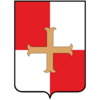Moreas Voivodeship
Moreas
| |
|---|---|
| Βοεβοδάτον τοῦ Μωρέως transcription(s) | |
| • Romanisation | Voevoðáton tũ Mōréōs |
| Воѥводьство Мѡрєꙗ transcription(s) | |
| • Romanisation | Vojevod'stvo Mōreja |
| • Glagolitic script | Ⰲⱁⰵⰲⱁⰴⱐⱄⱅⰲⱁ Ⰿⱉⱃⰵⱑ |
| Mottoes: | |
| Anthem: «Τὸ τραγούδι τοῦ Μωρέως» "Song to Moreas" | |
 | |
| Coordinates: Čěrneś: 37°38ʼ24.0"N 21°49ʼ39.8"E Sisypheia: 37°55ʼ54.2"N 22°54ʼ54.8"E | |
| Micronation | |
| Established | 1 March 2021 AD |
| Founded by | Quintus De Vitaliis |
| Named for | Morea |
| Seat | Dimitrijević Mansion, Čěrneś (current) Kost'rě Kapsalî, Kapsala, Čěrneś (planned) |
| Boroughs | |
| Government | |
| • Voivode | (TBD) |
| Demonyms | Μωραΐτης (m.), Μωραΐτισσα (f.) Мѡраїтъ (m.), Мѡраїта (f.) |
| Languages | |
| • Official | Hellenic South Ruthenian |
| • Minority | Arvanitika |
| • Immigrant | Albanian, Urdu |
| Time zone | UTC+02:15 (Græcian Eastern Time) |
| • Summer (DST) | UTC+03:15 (Græcian Eastern Summer Time) |
| Postal code | Čěrneś: 22008 Sisypheia: 20100 |
| Area code | +30 |
| Vehicle registration | CR SI |
Moreas Voivodeship (Hellenic: Βοεβοδάτον τοῦ Μωρέως, romanised: Voevoðáton tũ Mōréōs, pronounced: [voevoˈðaton tûː mɔːˈreɔːs]; South Ruthenian: Воѥводьство Мѡрєꙗ, romanised: Vojevod'stvo Mōreja, pronounced: [vo.jeˈvodʲstvo mɔːˈre.ja]) is one of the five voivodeships of Græcia, the top-level administrative divisions of the micronation. It was formed in March 2021 AD. As of 2022 AD, it consists of 2 boroughs located entirely within the same macronational prefecture.
Name
Moreas Voivodeship was named after Morea, the Medieval name of Peloponnese. For the sake of brevity, the voivodeship is referred to as Moreas (Hellenic: Μωρεύς, romanised: Mōrévs [mɔːˈrefs]; Neoclassical Latin: MOREA [ˈmɔreä]; South Ruthenian: Мѡрєй, romanised: Mōrej [mɔːˈrej]).
History
The Voivodeship was formed on 1 March 2021 AD, following the rapid expansion of Græcia to three macronations, outside of Hellas. It is composed of one of the original boroughs of Græcia, Čěrneś, and one that was formed later, Sisypheia.
Subdivisions
The Voivodeship is subdivided into 2 boroughs, one of which has 4 districts:
| Borough | Area (km²) | Area of influence (km²) | Administrative seat | District(s) |
|---|---|---|---|---|
| Čěrneś | TBD | TBD | Dimitrijević Mansion, Main street |
Kapsala Moustreca Ćougově Xŕb'tě |
| Sisypheia | TBD | TBD | St. George's Castrum, Platonos street |
n/a |
Government
Current Voivode: TBD
The voivodeship assembly is composed of 15 counselors, organised as follows:
- Čěrneś representatives - 8
- Kapsala representatives - 2
- Moustreca representatives - 2
- Ćougově representatives - 2
- Xŕb'tě representatives - 2
- Sisypheia representatives - 7
Economy
Moreas Voivodeship depends only on agriculture. The borough of Čěrneś produces olives, olive oil, potatoes, dairy products, while the borough of Sisypheia produces lemons, bitter oranges, and citrons.
Geography
Both constituents of the Voivodeship are located in the prefecture of Peloponnese, Hellas, albeit in different regional units: Čěrneś is located in Arcadia, whereas Sisypheia is located in Corinthia. Their areas of influence are mostly above sea level.
Demographics
Population
| Borough | District | Population (2022) | Citizens (2022) | Other subjects (2022) |
|---|---|---|---|---|
| Čěrneś | Kapsala | 2 | 2 | 0 |
| Čěrneś | Moustreca | 5 | 5 | 0 |
| Čěrneś | Ćougově | 6 | 2 | 4 |
| Čěrneś | Xŕb'tě | 5 | 5 | 0 |
| Sisypheia | n/a | 10 | 7 | 3 |
Religion
All of the people living in the Voivodeship are Greek Orthodox Christians, while there is a minority of seasonal workers who are muslims. The patron saint of the voivodeship is Paul the Apostle, whose feast is celebrated on 29 June.
Language
The official languages of the Voivodeship are Hellenic, and South Ruthenian, both of which are used for official documents, as well as everyday things. The people who live in Čěrneś are predominantly Ruthenophones, while those in Sisypheia speak Hellenic. There is also a significant minority in the latter who speak Arvanitika. Therefore, it is a recognised minority language within the voivodeship. Although not recognised, there are two spoken immigrant languages: Albanian, and Urdu.

